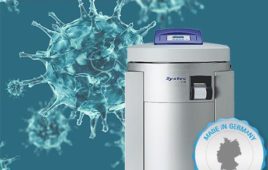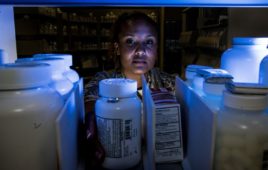The primary objective of a cleanroom disinfectant program is to control contamination in the production environment so that safe, pure, and effective drugs can be manufactured. There are challenges inherent in this task due to a number of factors in the drug manufacturing environment including: facility design issues such as HVAC, traffic flow, and substrate selections; personnel issues such as training, compliance, and supervision; and issues concerning the development and implementation of the disinfectant program.

In many cases, little can be done to rectify facility design issues without committing to significant expense and down time. In some cases, this commitment must be made in order to establish a controllable environment.
Personnel management may also be challenging depending upon the degree of training and supervision available. People are not processes. They cannot be validated but they can be trained and supervised. Unfortunately, all too often supervisors spend the majority of their time either attending meetings or writing reports, leaving little time for employee supervision.
Resolving facility design issues and personnel management issues should be a priority when there are environmental control problems. However, a well-developed and executed disinfectant program may be able to address deficiencies in these areas as part of both a short-term solution and a long-term strategy for environmental control. Cleanroom management must consider microbial control, residue control, substrate compatibility, personnel safety, and regulatory compliance in the development of any disinfectant program.
Threats from Microorganism
Arguably, microorganisms are the origin of life on this planet. Whether one subscribes to this belief or not, one thing is certain; they have been in existence for a very long time and can be found virtually anywhere on the planet, having adapted to specific climates and functions with unparalleled ease. The longevity and diversity of these organisms is both awe inspiring and frightening.
While they have been useful in everything from drug production to providing food for larger creatures in the ecosystem, microorganisms have also been the causative agent in some of the most devastating diseases known to man. Examples include HIV (AIDS) and Spanish influenza, both viruses, which together are speculated to have killed or infected over 100 million people. Food-related bacterial (E. coli) and viral (Hepatitis A) infections kill or sicken hundreds of thousands of people every year. Nosocomial infections (from caregivers to patients), including transmission of antibiotic-resistant strains of Staphylococcus aureus, have led to thousands of deaths, extended hospital stays, and billions of dollars in increased medical costs.
There is no doubt that microorganisms have a tremendous potential to cause harm, especially when they are present in parenteral drugs which are delivered into the human body in such a way that they bypass the body’s defense systems. The harm can result from direct or indirect injury to the patient. For example, as this article is being written the United States is facing a shortage of flu vaccine due to sterility failures at the manufacturer that resulted in the rejection of 50 million doses. It is not hyperbole to suggest that lives will be lost due to delays and the unavailability of this vaccine.
In addition to human cost, there is a real financial cost involved in poor microbial control. This cost includes lost production time and lost product. Ironically, most microorganisms are very easy to kill as long as the disinfectant program is thoroughly planned and well executed.
Disinfectant Options
The chemicals most widely used in disinfectant formulations attack microorganisms in both broad and specific ways. For example, the extremely low or high pH levels of many of these products may present an inherently hostile environment to certain organisms, while the active ingredients (ortho phenyl phenol or benzalkonium chloride, for example) make a targeted attack on a specific cell structure. In other words, different disinfectant formulations work differently against various organisms. Furthermore, not all organisms have the same susceptible cell structures. There are real differences in susceptibility between a vegetative bacterium and a spore former, for example.
Disinfectants should be selected on the basis of performance against common environmental contaminants and more than one product must be included in the disinfectant program in order to achieve broad-spectrum performance. The program should include routine disinfectants, sporicides, and residue reducing agents.
Routine disinfectants are those that contain phenolic or quaternary ammonium chloride compounds as active ingredients. These products are widely used and well characterized in terms of performance against common bacteria, fungi, and viruses. The advantages of using these products are that they are safe for everyday use on common cleanroom substrates and they are safe and relatively low in toxicity for the user. They are also effective at handling soil loads that would inactivate other products, particularly oxidizing chemistries such as bleach and peracetic acid blends. Routine disinfectants are not effective against spore-forming organisms such as Bacillus subtilis and many provide minimally effective performance against resistant molds such as Aspergillus niger.
To control inherently challenging organisms such as spore-formers and molds, sporicides must be used as part of a long-term strategy. These chemistries include bleach, peracetic acid/hydrogen peroxide blends, and chlorine dioxide. The advantage of these chemistries is that they will eliminate all microbial life forms, including the most resistant forms, if applied correctly. This makes them well-suited for applications during a catastrophic failure (e.g. power outage) or when bringing a facility back on line after a preventative maintenance shutdown. Sporicides can also be used for more frequent applications as a preventative measure (i.e. weekly or monthly applications), or more frequently as part of a short-term strategy to address environmental monitoring failures until a root cause has been identified and a corrective action implemented. However, they should be used carefully since they can be corrosive even to 316 stainless steel and challenging for personnel to work with due to their odor and the potential for irritation.
Residue Control
All formulated disinfectants and sporicides will leave residues on surfaces after application. These residues may be inadvertently transferred to product contact areas and pose a risk of product contamination if left untreated. Additionally, these residues may lead to functional problems (e.g. sticky doors) and aesthetic challenges (e.g. visible residue on curtains) in the environment. Therefore, it is important to incorporate a chemical residue control strategy into your disinfectant program.
Isopropyl alcohol (IPA) has been used to wipe down surfaces in cleanrooms for decades. Although IPA does have antimicrobial properties, the manner in which it is being used makes it more effective as a residue-reducing agent. However, recent concerns about lowered Permissible Exposure Limits (PEL) and Threshold Limit Values (TLV) for IPA and volatile organic compounds have forced cleanroom management to search for alternatives. One alternative is 3% hydrogen peroxide. Like IPA, it does have antimicrobial properties but its ability to handle soil is limited and at this concentration it is not sporicidal.
Both IPA and 3% hydrogen peroxide are well suited as residue-reducing agents. Additionally, pure water (e.g. water-for-injection) can be used to remove residues from large surface areas. There are also products that are “formulated” and marketed to remove residue but they often contain non-volatile materials that will leave additional residues on surfaces. Residue-reducing agents should be residue-free whenever possible.
Facility Design and Condition
Cleanroom construction and operation are large investments for a facility. Over the lifetime of an operational cleanroom it will be exposed to thousands of liters of cleaning solutions, including disinfectants, sporicides, and residue-reducing agents. The compatibility between these chemistries and the room’s surfaces (substrates) is very important to maintaining the integrity of the cleanroom. A facility that has rusted, pitted, and otherwise damaged surfaces caused by chemical exposure will be both unsightly and difficult to disinfect.
Substrate compatibility is affected by several factors including the nature and use-concentration of the microbial control chemistry (e.g. its pH, its active substance, and the presence of oxidizers), the frequency of application, and the choice of residue remediation efforts. These factors must be balanced with microbial control objectives when designing a disinfectant program. They will impact the rationale for how disinfectants are used for daily cleaning and when residue reducing agents and sporicides are needed. A cleanroom cannot be properly maintained by using only one type of product.
Personnel safety is another important consideration that should be balanced with microbial control objectives. Most antimicrobial products suited for use in cleanrooms can cause personnel discomfort or harm if used inappropriately. In particular, concentrated formulations that require significant dilution with water before use must be handled with care since they have the greatest potential to cause harm if exposure is not prevented. Additionally, management must assess the potential for inadvertently mixing different chemicals used in the same area and must implement preventative measures. The mixing of chemistries can lead to the creation of toxic gases and other potential dangers.
USP 1072: Disinfectants and Antiseptics, In-Process Revision, Pharmacopeial Forum, Vol. 29 (3) [May-June 2003] is an advisory document for the elements of an effective disinfectant program that is written from a regulatory perspective. This document specifically addresses microbial control, residue control, substrate compatibility, and personnel safety. Here is what this document states about some of these issues:
“ It is prudent to augment the daily use of a bactericidal disinfectant with weekly (or monthly) use of a sporicidal agent. The daily application of sporicidal agents is not generally favored because of their tendency to corrode equipment and because of the potential safety issues with chronic operator exposure. Disinfectants applied on potential product contact surfaces are typically removed with 70% alcohol wipes. The removal of residual disinfectants should be monitored for effectiveness against the possibility of product contamination.”
“The greatest safety concerns are in the handling of concentrated disinfectants and the mixing of incompatible disinfectants. For example, concentrated sodium hypochlorite solutions (at a concentration of more than 5%) are strong oxidants and will decompose on heating, on contact with acids, and under the influence of light, producing toxic and corrosive gases including chlorine.”
Disinfectant Validation
The USP 1072 document also provides input on disinfectant validation, an area of particular concern to regulatory authorities such as the Food and Drug Administration or the European Medicines Agency. Disinfectant validation includes not only in vitro studies demonstrating a disinfectant’s performance against specific organisms under controlled conditions but also an environmental assessment of how the disinfectant is performing under actual use conditions. To quote the document:
“ To demonstrate the efficacy of a disinfectant within a pharmaceutical manufacturing environment, it may be deemed necessary to conduct the following tests: (1) use-dilution tests (screening disinfectants for their efficacy at various concentrations and contact times against a wide range of standard test organisms and environmental isolates); (2) surface challenge tests (using standard test microorganisms and microorganisms that are typical environmental isolates, applying disinfectants to surfaces at the selected use concentration with a specified contact time, and determining the log reduction of the challenge microorganisms); and (3) a statistical comparison of the frequency of isolation and numbers of microorganisms isolated prior to and after the implementation of a new disinfectant.”
“This is considered necessary because critical process steps like disinfection of aseptic processing areas, as required by GMP regulations, need to be validated…”
Training and Compliance
The success of a disinfectant program is directly related to the quality of training provided to the personnel charged with executing the program and the degree to which they comply with the disinfectant protocol. Most disinfectant program failures occur either because the wrong chemistry was selected or because the right chemistry is not being applied properly.
Training programs should include basic microbiology and basic chemistry related to disinfectant preparation and application including safety, aseptic techniques, and a job-related standard operating procedure based upon proper testing and validation. In vitro data will confirm that the right chemistry is being used but environmental monitoring is the only way to determine that the program is being successfully implemented through proper application.
Summary
A cleanroom’s disinfectant program should be viewed as part of its entire microbial control program, the outcome of which cannot be greater than the sum of its parts. The success of any microbial control program depends upon many factors, including the facility’s design and condition, the thoroughness of personnel training and compliance, and the development of a validated disinfectant program.
If a facility experiences an aseptic production failure, each of these elements should be evaluated to identify problems and re-establish microbial control. However, if a manufacturer has thoroughly addressed all of these elements during the initial planning of the disinfectant program, their successes will far outpace their failures.
Elaine Kopis Sartain is Director of Technical Service for Life Sciences Cleaning Chemistries, STERIS Corporation, 5960 Heisley Road, Mentor, OH 44060. She can be reached at 314-290-4792 or [email protected].



